| Article ID | Journal | Published Year | Pages | File Type |
|---|---|---|---|---|
| 9459858 | Atmospheric Research | 2005 | 25 Pages |
Abstract
An ozone lidar was successfully operated as a ground-based instrument during the ESCOMPTE experiment in June/July 2001. Ozone profiles were measured between 0.5 and 5 km. Moreover, simultaneous measurements of the lidar scattering ratio (SR) at 316 nm diagnosed the diurnal evolution of the PBL top. Comparison of this data set with in-situ measurements by ultralight aircraft (ULM) and balloon soundings supports the existence of well-defined layers over the whole altitude range. Differences between measurements techniques are not due to instrumental inaccuracies but point towards the existence of ozone plumes with sharp horizontal gradients. This is indeed supported by aircraft horizontal cross-section available twice a day at two different levels in the planetary boundary layer (PBL) and the free troposphere. Analysis of the ozone data set has shown a good correlation between surface meteorological conditions, surface ozone measurements and lidar ozone profiles in the PBL. Observed ozone maxima or minima are linked either to sea breeze circulation bringing polluted air masses over the lidar or synoptic flows bringing air with background O3 values into the region. The observed variability of the ozone field is very large over the whole altitude range. Although it is the result of local temporal variability and advection of spatial inhomogenities, the latter proved to be an important contribution.
Related Topics
Physical Sciences and Engineering
Earth and Planetary Sciences
Atmospheric Science
Authors
G. Ancellet, F. Ravetta,
